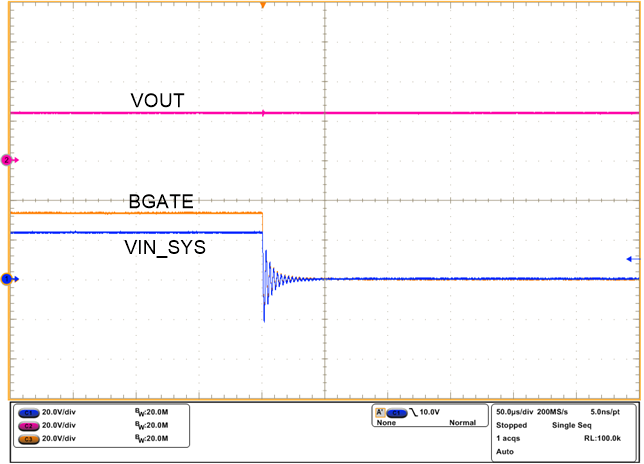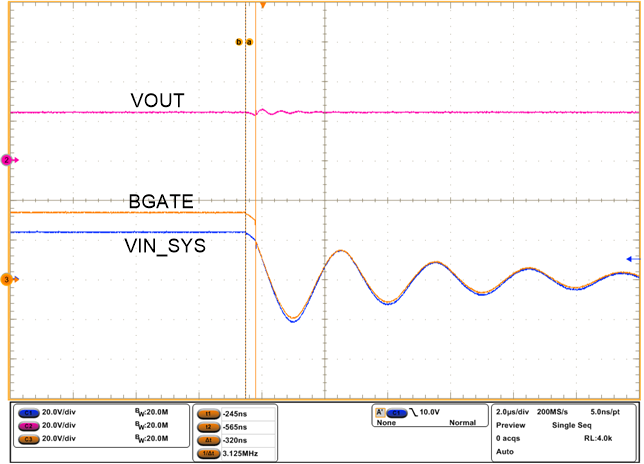ZHCSIU6G September 2018 – June 2024 TPS2663
PRODUCTION DATA
- 1
- 1 特性
- 2 应用
- 3 说明
- 4 Device Comparison Table
- 5 Pin Configuration and Functions
- 6 Specifications
- 7 Parameter Measurement Information
-
8 Detailed Description
- 8.1 Overview
- 8.2 Functional Block Diagram
- 8.3
Feature Description
- 8.3.1 Hot Plug-In and Inrush Current Control
- 8.3.2 PGOOD and PGTH
- 8.3.3 Undervoltage Lockout (UVLO)
- 8.3.4 Overvoltage Protection (OVP)
- 8.3.5 Input Reverse Polarity Protection (B_GATE, DRV)
- 8.3.6 Reverse Current Protection
- 8.3.7 Overload and Short-Circuit Protection
- 8.3.8 Output Power Limiting, PLIM (TPS26632, TPS26633, TPS26635, TPS26636, and TPS26637 Only)
- 8.3.9 Current Monitoring Output (IMON)
- 8.3.10 FAULT Response (FLT)
- 8.3.11 IN_SYS, IN, OUT, and GND Pins
- 8.3.12 Thermal Shutdown
- 8.3.13 Low Current Shutdown Control (SHDN)
- 8.4 Device Functional Modes
-
9 Application and Implementation
- 9.1 Application Information
- 9.2
Typical Application: Power Path Protection in a PLC System
- 9.2.1 Design Requirements
- 9.2.2 Detailed Design Procedure
- 9.2.3 Application Curves
- 9.3 System Examples
- 9.4 Dos and Do Nots
- 9.5 Power Supply Recommendations
- 9.6 Layout
- 10Device and Documentation Support
- 11Revision History
- 12Mechanical, Packaging, and Orderable Information
封装选项
请参考 PDF 数据表获取器件具体的封装图。
机械数据 (封装 | 引脚)
- RGE|24
- PWP|20
散热焊盘机械数据 (封装 | 引脚)
订购信息
8.3.6 Reverse Current Protection
The device monitors V(IN_SYS) and V(OUT) to provide true reverse current blocking when a reverse condition or input power failure condition is detected. The reverse comparator turns OFF the external blocking FET Q1 quickly as soon as V(IN_SYS) – V(OUT) falls below –1 V. The total time taken to turn OFF the FET Q1 in this condition is tRCB(fast_dly) + t(Driver). Use Equation 4 to calculate the delay due to the driver stage t(Driver).

where
- RDSON(Q2) is the on resistance of the fast pulldown switch Q2
- Ciss(Q1) is the input capacitance of the blocking FET Q1
- VGTH(Q1) is the GATE threshold voltage of the blocking FET Q1
- VBGATE = 10.2 V (typical)
In a typical system design, t(Driver) is generally 10% to 20% of tRCB(fast_dly) of 120 ns (typical).
Figure 8-10 and Figure 8-11 illustrate the behavior of the system during input hot short-circuit condition. The blocking FET Q1 is turned ON within 1.6 ms (typical) after the differential forward voltage V(IN_SYS) – V(OUT) exceeds 67 mV (typical).
 Figure 8-10 Input Hot-Short
Functionality at 24-V Supply
Figure 8-10 Input Hot-Short
Functionality at 24-V Supply Figure 8-11 Input Hot-Short:
Fast-Trip Response (Zoomed)
Figure 8-11 Input Hot-Short:
Fast-Trip Response (Zoomed)The reverse comparator architecture has a supply line noise immunity resulting in a robust performance in noisy environments. This event is achieved by controlling the turn-OFF time of the internal FET based on the over-drive differential voltage V(IN_SYS) – V(OUT) over V(REVTH). The higher the over-drive, the faster the turn-OFF time, tRCB(dly).